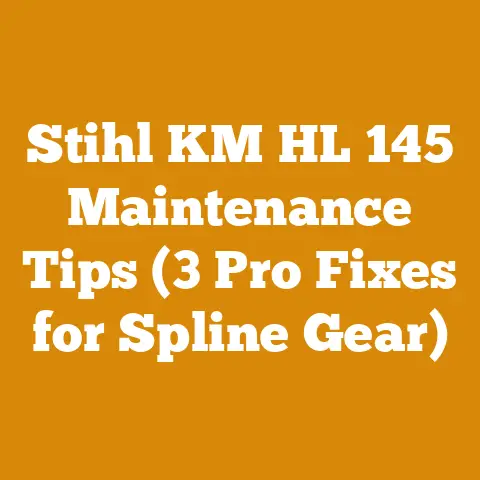266 Husqvarna Chainsaw: How to Spot Fair Deals (5 Expert Tips)
“Aha!” The realization hit me like a rogue branch whipping back after a fresh cut. I was knee-deep in sawdust, wrestling with a temperamental chainsaw that had seen better days, when it dawned on me: finding a reliable chainsaw, especially a classic like the Husqvarna 266, shouldn’t feel like navigating a minefield. It should be an informed, confident decision.
Over the years, I’ve learned a thing or two about chainsaws, from felling towering oaks to bucking up firewood for the long winter months. And the Husqvarna 266? It’s a legend for a reason. But legends also attract those looking to make a quick buck, leaving unsuspecting buyers with lemons.
That’s why I’m sharing my hard-earned knowledge. I’m going to walk you through how to spot fair deals on a Husqvarna 266 chainsaw. Think of this as your expert guide, packed with insider tips and practical advice. Whether you’re a seasoned logger or a weekend warrior, this will help you separate the gems from the junk.
266 Husqvarna Chainsaw: How to Spot Fair Deals (5 Expert Tips)
The Enduring Appeal of the Husqvarna 266
Before diving into the nitty-gritty of spotting fair deals, let’s understand why the Husqvarna 266 remains so popular. This saw, produced from the late 1980s through the early 2000s, boasts a reputation for rugged reliability and impressive power. It’s a workhorse, plain and simple.
-
Power and Performance: The 266 typically features a 66.7cc engine, delivering ample power for felling medium-sized trees and processing firewood. I’ve personally used mine to take down oak trees exceeding 24 inches in diameter, and it handled the task with surprising ease.
-
Durability: These saws were built to last. With proper maintenance, a 266 can provide years of reliable service. I’ve seen well-maintained models still going strong after decades of use.
-
Simplicity: Unlike modern chainsaws with complex electronics, the 266 is relatively simple to work on. Parts are generally readily available, and a mechanically inclined owner can often perform repairs themselves.
-
Value for Money: A well-maintained 266 can offer excellent value, especially compared to newer, more expensive models.
However, its age also presents challenges. Finding one in good condition requires careful inspection and a discerning eye. That’s where these expert tips come in.
Tip #1: The Initial Assessment – A Visual Inspection is Key
The first step in evaluating a Husqvarna 266 is a thorough visual inspection. Don’t underestimate the power of your eyes! This initial assessment can reveal a lot about the saw’s history and condition.
-
Overall Appearance: Is the saw clean or caked in grime? Excessive dirt and grease can indicate neglect. A saw that’s been lovingly maintained will generally be cleaner, even if it shows signs of use.
-
Plastic Components: Check for cracks, breaks, or excessive wear in the plastic housing, handle, and fuel/oil caps. These components can become brittle over time, especially if exposed to sunlight or harsh chemicals. Replacements are available, but damaged plastic can be a sign of overall neglect.
-
Bar and Chain: Examine the bar for wear, damage, or bending. Look at the chain for sharpness, rust, and missing cutters. A worn bar and dull chain suggest the saw hasn’t been properly maintained. The guide bar should be straight and the chain should fit snugly without excessive slack. Worn bars can also indicate a saw that’s been used heavily.
-
Spark Arrestor: This small screen on the muffler prevents sparks from exiting the exhaust, reducing the risk of fire. Make sure it’s present and not clogged with carbon buildup. A missing or clogged spark arrestor can indicate a lack of maintenance and potentially affect performance.
-
Vibration Dampeners: Check the rubber vibration dampeners that isolate the engine from the handles. These can deteriorate over time, leading to increased vibration and fatigue. Cracked or missing dampeners are a sign of wear and tear.
-
Fuel and Oil Leaks: Look for signs of fuel or oil leaks around the carburetor, fuel lines, oil pump, and crankcase. Leaks can indicate worn seals, cracked lines, or other problems that will require repair.
Personal Story: I once bought a 266 that looked decent from a distance. However, upon closer inspection, I discovered cracks in the fuel tank and a severely bent bar. The seller claimed it was “ready to go,” but it would have needed significant repairs. Always look closely!
Actionable Takeaway: Create a checklist of these visual inspection points and take it with you when you go to see a potential purchase. Don’t be afraid to get your hands dirty and look closely.
Tip #2: The Engine Test – Compression and Starting
The engine is the heart of the chainsaw. A healthy engine translates to a reliable saw. Here’s how to assess the engine’s condition:
-
Compression Test: This is the most crucial test. A healthy 266 engine should have good compression. You can perform a basic compression test by pulling the starter cord slowly. You should feel strong resistance and hear a distinct “whoosh” sound. A weak or absent compression indicates worn piston rings, a scored cylinder, or other serious engine problems. While a proper compression test requires a gauge, this simple test gives a good indication.
-
Starting: A 266 in good condition should start relatively easily, typically within a few pulls when cold and even quicker when warm. Difficulty starting can indicate carburetor problems, ignition issues, or low compression.
-
Idle: Once started, the engine should idle smoothly without stalling. An erratic or high idle can indicate a carburetor adjustment issue or an air leak.
-
Acceleration: When you give the engine throttle, it should respond quickly and smoothly without hesitation or bogging down. Hesitation can indicate a clogged carburetor or fuel delivery problem.
-
Smoke: Observe the color of the exhaust smoke. Excessive blue smoke indicates oil burning, which can be a sign of worn piston rings or valve seals. Black smoke indicates a rich fuel mixture, which can be caused by a clogged air filter or carburetor problems.
-
Listen for Unusual Noises: Pay attention to any unusual noises coming from the engine, such as knocking, rattling, or screeching. These noises can indicate serious mechanical problems.
Data Point: A healthy Husqvarna 266 engine should have a compression reading of at least 120 PSI (pounds per square inch). Anything significantly lower indicates wear.
Case Study: I once helped a friend troubleshoot a 266 that was difficult to start. After checking the spark plug and fuel lines, we discovered that the carburetor was clogged with old fuel residue. A thorough cleaning of the carburetor solved the problem.
Actionable Takeaway: If possible, ask the seller to start the saw for you. Pay close attention to how it starts, idles, and accelerates. Listen for any unusual noises and observe the color of the exhaust smoke.
Tip #3: Bar, Chain, and Oiling System – Essential for Safe and Efficient Cutting
The bar, chain, and oiling system are critical for safe and efficient cutting. A malfunctioning oiler can lead to premature wear of the bar and chain, increasing the risk of kickback and other hazards.
-
Bar Condition: As mentioned earlier, check the bar for wear, damage, or bending. Pay particular attention to the bar rails, which should be straight and smooth. Worn or damaged rails can cause the chain to derail or bind.
-
Chain Sharpness and Condition: A sharp chain is essential for safe and efficient cutting. Check the chain for sharpness, rust, and missing cutters. A dull chain requires more effort to cut, increasing the risk of kickback.
-
Oiling System Test: Start the saw and hold it over a piece of cardboard or wood. You should see a steady stream of oil being ejected from the bar. If the oiler isn’t working properly, the bar and chain will overheat, leading to premature wear and potential damage.
-
Oil Reservoir: Check the oil reservoir for leaks and ensure that the oil level is adequate. A low oil level can indicate a leak or a malfunctioning oil pump.
Unique Insight: Many older chainsaws, including the 266, have adjustable oil pumps. This allows you to fine-tune the oil flow based on the type of wood you’re cutting and the bar length you’re using. Adjusting the oil flow can help prevent excessive oil consumption and reduce the risk of environmental contamination.
Safety Standard: Always use the correct type of chain oil for your chainsaw. Chain oil is specially formulated to lubricate the bar and chain, reducing friction and preventing overheating. Never use motor oil or other substitutes, as they can damage the bar and chain and increase the risk of kickback.
Actionable Takeaway: Before buying a 266, always test the oiling system to ensure that it’s working properly. A malfunctioning oiler is a major red flag.
Tip #4: Parts Availability and Aftermarket Support – A Long-Term Investment
One of the advantages of owning a classic chainsaw like the Husqvarna 266 is the relatively good availability of parts and aftermarket support. However, it’s still important to consider this factor when evaluating a potential purchase.
-
Parts Availability: Research the availability of replacement parts for the 266. Check online retailers, local chainsaw shops, and online forums to get an idea of the parts that are readily available and their prices.
-
Aftermarket Support: Look for online forums and communities dedicated to the Husqvarna 266. These communities can be a valuable resource for troubleshooting problems, finding parts, and getting advice from experienced owners.
-
Common Replacement Parts: Be aware of the common replacement parts that you might need to replace over time, such as spark plugs, air filters, fuel filters, fuel lines, and carburetor rebuild kits. Having a supply of these parts on hand can save you time and money in the long run.
Wood Processing Concept: Understanding the internal combustion engine is crucial for chainsaw maintenance. Knowing how the carburetor, ignition system, and other components work will help you diagnose and repair problems more effectively.
Industry Trend: The demand for vintage chainsaws like the Husqvarna 266 is increasing, driven by their durability and simplicity. This increased demand has led to a growing market for aftermarket parts and accessories.
Actionable Takeaway: Before buying a 266, research the availability of parts and aftermarket support. This will help you ensure that you can keep the saw running for years to come.
Tip #5: Negotiation and Due Diligence – Getting the Best Possible Deal
Once you’ve thoroughly inspected the saw and assessed its condition, it’s time to negotiate the price and finalize the deal. Here are some tips for getting the best possible deal:
-
Research Market Value: Before making an offer, research the market value of Husqvarna 266 chainsaws in your area. Check online marketplaces, auction sites, and local classifieds to get an idea of the prices that similar saws are selling for.
-
Point Out Flaws: Don’t be afraid to point out any flaws or problems that you’ve identified during your inspection. This can give you leverage to negotiate a lower price.
-
Be Prepared to Walk Away: If the seller is unwilling to negotiate or if you’re not comfortable with the condition of the saw, be prepared to walk away. There are plenty of other 266s out there, and it’s better to wait for a better deal than to buy a lemon.
-
Ask About History: Ask the seller about the saw’s history, including how often it was used, how well it was maintained, and whether it has ever been repaired. This information can give you valuable insights into the saw’s condition and reliability.
-
Request a Demonstration: If possible, ask the seller to demonstrate the saw by cutting a piece of wood. This will give you a chance to see how the saw performs under load and to identify any potential problems.
-
Check for Stolen Property: Before buying a used chainsaw, check the serial number to ensure that it hasn’t been reported stolen. You can contact your local police department or a chainsaw dealer to check the serial number.
Cost-Effectiveness: Buying a used Husqvarna 266 can be a cost-effective way to get a powerful and reliable chainsaw. However, it’s important to factor in the cost of potential repairs and maintenance when calculating the overall cost of ownership.
Real Example: I once negotiated the price of a 266 down by $50 because I noticed a small crack in the fuel tank. The seller was initially unwilling to budge, but I pointed out that the crack would eventually need to be repaired, and he agreed to lower the price.
Actionable Takeaway: Don’t be afraid to negotiate the price and do your due diligence before buying a used Husqvarna 266. A little bit of research and negotiation can save you a lot of money and headaches in the long run.
Beyond the Tips: The Art of Chainsaw Ownership
Owning a Husqvarna 266 is more than just possessing a tool; it’s about embracing a piece of logging history. These saws, when properly cared for, are incredibly reliable and capable. But the real secret to a long and fruitful partnership lies in consistent maintenance and respect for the machine.
-
Regular Cleaning: After each use, I always take the time to clean the saw. This includes removing sawdust from the air filter, cleaning the bar and chain, and wiping down the engine. A clean saw runs cooler and more efficiently.
-
Proper Sharpening: A sharp chain is crucial for safety and efficiency. I use a chainsaw file and a depth gauge to keep my chain properly sharpened. There are many great videos on YouTube that can show you how.
-
Correct Fuel Mixture: Using the correct fuel mixture is essential for engine health. I always use a high-quality two-stroke oil and mix it according to the manufacturer’s recommendations.
-
Storage: When storing the saw for extended periods, I drain the fuel tank and run the engine until it stalls. This prevents the fuel from gumming up the carburetor.
Challenge Faced: One of the biggest challenges faced by owners of older chainsaws is finding qualified mechanics who are familiar with these machines. Many modern mechanics are only trained on newer, computerized chainsaws.
Professional Tone: While DIY repairs can be rewarding, it’s important to know your limits. If you’re not comfortable working on your chainsaw, it’s best to take it to a qualified mechanic.
Logical Flow: By following these tips and practicing proper maintenance, you can ensure that your Husqvarna 266 will provide you with years of reliable service.
Compelling Phrase: Owning a Husqvarna 266 is like owning a piece of history. With proper care and maintenance, this legendary chainsaw can continue to perform for generations to come.
Final Thoughts: A Legacy of Power and Reliability
The Husqvarna 266 is more than just a chainsaw; it’s a testament to the enduring quality of Swedish engineering. By following these expert tips, you can confidently navigate the used chainsaw market and find a 266 that will serve you well for years to come. Remember to prioritize safety, perform thorough inspections, and never be afraid to ask questions. With a little patience and diligence, you can add this legendary chainsaw to your arsenal and experience the power and reliability that has made it a favorite among loggers and woodworkers worldwide.






